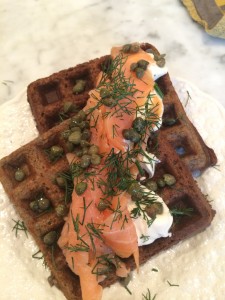The answer to the question keeping you up at night
I know what’s making you toss and turn at 3 A.M., and it’s not your daughter’s report card or your nutty client. But fret no more! The tossing and turning can stop, because I have the answer to the question keeping you up at night. Are you ready? Here it is:
Buckwheat is not a wheat.
Wait, that wasn’t the issue that was causing you middle-of-the-night crazies?
Well, at least now you can stop wondering about whether or not buckwheat contains gluten (it doesn’t). Buckwheat, in fact, is not even in the wheat family. And it’s not even a grain — buckwheat is a seed from a plant in the rhubarb family. Go figure.
So how did this gluten-free seed come to have the word ‘wheat’ in its name? Anybody’s guess, but my personal theory is that some wily farmer realized that buckwheat can do lots of things that wheat can do, so he began saying, “Yeah, yeah, it’s just like wheat; in fact we call it . . . yeah, that’s it . . . buckwheat.” (This was back in the day before the marketing and branding of food required focus groups and such.) And, as they say on late-night TV, that’s not all! Aside from being gluten-free, buckwheat is a good source of protein, fiber and other micronutrients such as manganese and magnesium. There is research to suggest that buckwheat can help stabilize blood sugar levels, too.
Feel better about the whole buckwheat/wheat question? Good.
Now, let’s have a quick chat about a couple of wonderful things you can do with buckwheat.
Let’s start with soba noodles . . . the 100% buckwheat kind. It’s true you can find soba noodles that are 50/50 wheat/buckwheat, but I love the nutty taste of pure buckwheat soba noodles. For years I found them difficult to cook, until I learned a trick from a wonderful Yotem Ottolenghi recipe for soba with eggplant and mango. I now know that it is crucial to rinse soba noodles with cool water after they have been boiling to stop the cooking and prevent the noodles from turning into sludge. Once drained and rinsed, the noodles are ready for anything: sling them into a flavorful broth, use them as a bed for ginger-poached fish, or maybe turn them into sesame noodles. Recently I tossed soba noodles with cubes of roasted squash, bits of fresh orange, raw pak choi and shelled pistachios. The result was hearty yet light, in some weird but wonderful way. My recipe guinea pigs kept on reaching into the bowl for more.

Shabby-chic buckwheat waffles with smoked salmon
Of course, soba noodles are not the only buckwheat product around. There are buckwheat groats (a most unfortunate name) and groats’ toasted cousin, kasha. Some folks love the pilafs and porridges you can make with groats and kasha. I’m not quite there yet. Personally, I like working with buckwheat flour. In fact, my favorite waffles rely on buckwheat flour, oats and buttermilk. They are wonderful served with a bit of smoked salmon, creme fraiche, dill and capers — sort of a shabby-chic version of blinis with caviar. If someone you love needs sweet stuff on their waffles, these stand up well to a warm apple-maple compote. I was missing a bit of crunch in these waffles, so I sprinkled on millet after pouring the batter onto the waffle iron, but before closing the top. The result: crunchy, healthy, delicious.
Spritely Soba Noodles
By Published: March 1, 2015
- Yield: 4 Servings
- Prep: 25 mins
- Cook: 30 mins
- Ready In: 55 mins
Light and yet filling, flavorful and comforting, these noodles are delicious on cold winter nights when you need some bright flavors to cheer you.
Ingredients
- 2 pounds butternut squash peeled, seeded and cubed into 1-inch dice
- 1 teaspoon olive oil
- salt
- 1/4 cup rice wine vinegar
- 2 tablespoons roasted sesame oil
- 2 tablespoons maple syrup
- 1 clove garlic grated on a micro-plane grater or smashed
- 1 thumb ginger peeled and finely grated, about 1 1/2 teaspoons
- 1/2 cup chopped cilantro rinsed and ripped into large bits
- 12 ounces 100% buckwheat soba noodles
- 2 naval oranges
- 3 bunches baby pak choi rinsed and chopped
- 1/2 cup shelled, roasted, salted pistachios chopped
Instructions
- Preheat the oven to 400 degrees. Place the butternut squash dice on a large baking tray and toss with the olive oil and salt. Roast for 15-25 minutes until slightly carmelized and soft. Remove from the oven and set aside.
- While the squash is roasting, combine the rice wine vinegar, roasted sesame oil, maple syrup, ½ teaspoon of salt, grated garlic clove, grated ginger and chopped cilantro into a large bowl.
- To the bowl, add the zest of one orange (about 1 ½ tsp). Then 'supreme' both the zested and unzested oranges (that is, peel the oranges and cut the segments out from between the membranes). Add the supremed orange segments to the bowl
- Bring a large pot of salted water to a boil. Add the soba noodles to the boiling water. Cook for 8-9 minutes. Drain in a colander and rinse with cool water to stop the cooking. Immediately toss into the bowl with the oranges. Add in the roasted squash, chopped pak choi and chopped pistachios. Toss. Season well with salt and pepper.


Comments are closed.